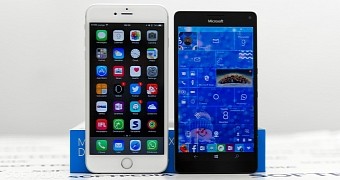I guess we all know by know that staying with Windows phones can no longer be considered a long-term commitment because sooner or later, Windows 10 Mobile as we know it is going to be retired.
And by the looks of things, it’s all going to happen very soon, with Microsoft already counting the days left until mid-2019 when Windows 10 Mobile is projected to reach end of support and finally go dark.
This makes the transition from Windows phones to an alternative platform a matter of time for pretty much everyone, and while some people migrated to Android or iOS already, others are trying to delay the switch as much as possible.
While I still keep my Lumia 950 XL around all the time, it’s pretty clear it can’t serve as my daily driver anymore, especially because I have tons of apps and I need a device that runs smoothly for my productivity needs. And even if I use an iPhone, it doesn’t necessarily mean it offers a flawless experience, and after such a long time, I still miss some Windows 10 Mobile features. One more than the others.
When comparing Windows 10 Mobile and iOS, it’s hard to believe the first has something that the latter lacks because, you know, customers are the ones who decide which one is better, and in this case, Apple is a clear winner. But iPhones lack several features that I considered to be super-handy on Windows 10 Mobile and one of them is live tiles.
Without a doubt, live tiles have always been the most praised feature of Windows phones, and just because of that, Microsoft was looking into ways to improve them even further. There were plans to introduce exploding tiles and to make them interactive, which would have essentially allowed users to perform certain tasks, such as controlling the music playback, without even launching the app and relying entirely on the live tile.
All these ideas were eventually abandoned, and with Windows 10 Mobile now in maintenance mode, it’s hard to believe any of them would ever see daylight.
“I really love how dynamic Windows phones truly are.”
On the other hand, the experience on an iPhone is completely different. Icons are completely static, and the only thing that I like are the notification badges. Which were available on Windows phones as well, anyway, but at least they’re there on iPhones too.
So when I say that I’d love the Windows 10 Mobile live tiles on iPhones, the main idea is that I miss how dynamic Windows phones actually were.
iOS hasn’t changed too much in the last few years, and the look of the operating system overall is pretty much the same, with only few design refinements here and there. But when it comes to functionality, usability, and productivity without launching the apps, iPhones are way behind Windows phones. And live tiles are the ones making the difference.
Live tiles have more or less survived the demise of Windows phones and are now available on the PC as well, as part of the Start menu. But needless to say, they were substantially more useful on a phone, where they were playing an essential role, technically because they were the first things people were seeing after starting their devices and the main way to interact with the content offered by apps.
On an iPhone, there’s no such thing. There are apps, we all know that, but you need to launch them to see any useful content. You also get widgets, which could be one way to address the lack of live tiles, though again not all apps support them and their approach is too complex and significantly more painful when it comes to interacting with content.
So yes, moving from a Windows phone, a platform that has no apps, to iOS, a platform that has all the apps, comes with drawbacks too, and if you were expecting the same dynamic experience on an iPhone, you’re going to be disappointed.
I know I am, and by the looks of things, iOS might not be my final destination. Android offers so much more when it comes to all of the above, and this is probably one of the reasons it’s currently number one.

 14 DAY TRIAL //
14 DAY TRIAL //